1. Prime and Composite Numbers
- Books Name
- CBSE Class 6 Mathematics Book
- Publication
- Param Publication
- Course
- CBSE Class 6
- Subject
- Mathmatics
Factors
Any number which is an exact divisor of a given number is called a factor of the given number.
For example factor of 6 are 1,2,3 and 6
Important results :
(a) 1 is a factor of every number.
(b) Every number is a factor of itself.
(c) Every factor of a number is always equal to or less than the number.
(d) Every number has a finite number of factors.
1. Prime and Composite Numbers
- Books Name
- Class 6 Mathematics Book
- Publication
- ReginaTagebücher
- Course
- CBSE Class 6
- Subject
- Mathmatics
CHAPTER - 03
PLAYING WITH NUMBERS
Prime and Composite Numbers
A Prime number is a number which has exactly two factors i.e. ‘1’ and the number itself. A composite number has more than two factors, which means piecemeal from getting divided by 1 and the number itself, it can also be divided by at least one positive integer. 1 isn't a prime or composite number. Except these two numbers, there's also same order of numbers which are co prime numbers.
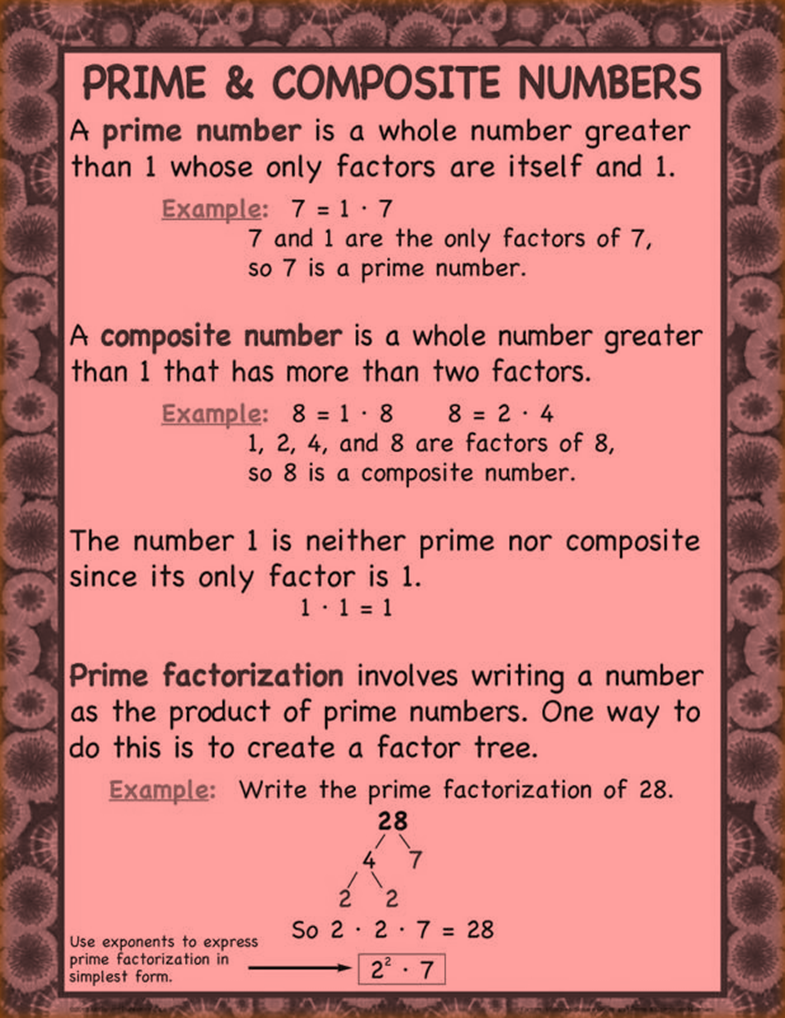
Detailed explanations of these numbers are given below.
Prime Numbers
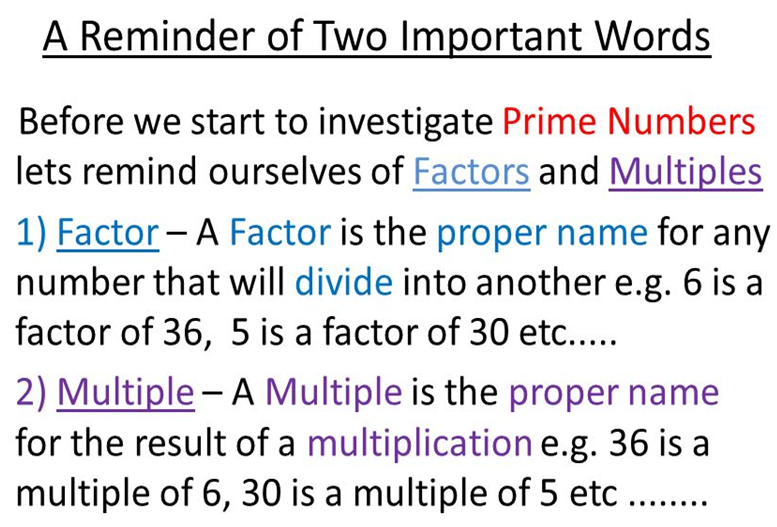
Illustration of Prime Number
3 is a prime number because 3 can be divided by only two numbers
i.e. 1 and 3 itself.
3/1 = 3
3/3 = 1
in the same way, 2, 5, 7, 11, 13, 17 are prime numbers.
Composite Numbers
A composite number has more than two factors, which means aside from getting divided by the number 1 and itself, it can also be divided by at least one integer or number. We don't consider ‘1’ as a composite number.
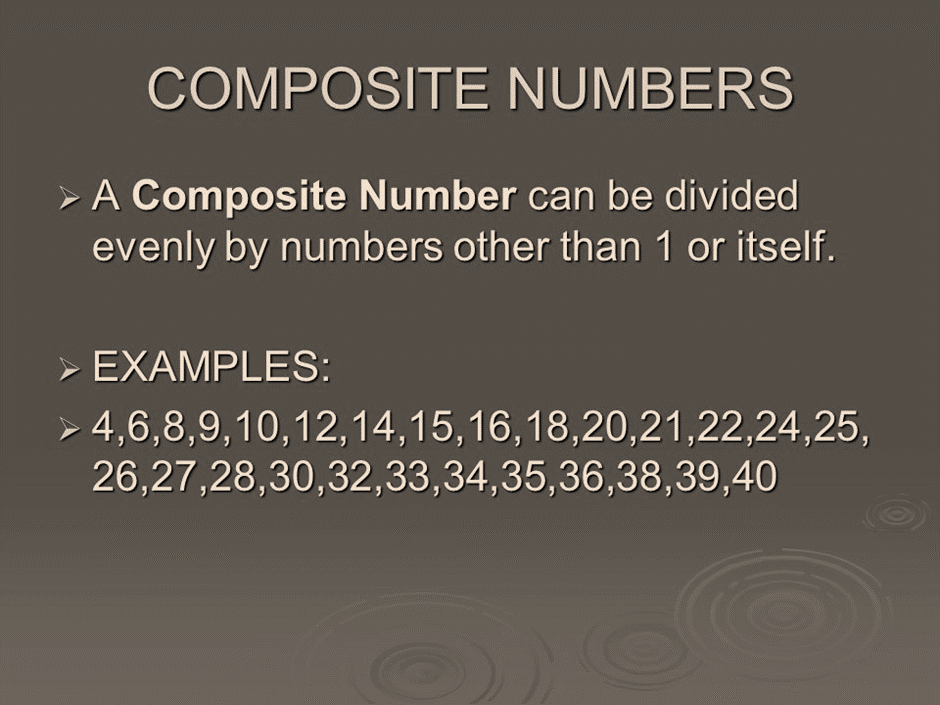
Illustration of Composite Number
12 is a composite number because it can be divided by 1, 2, 3, 4, 6 and 12. So, the number ‘12’ has 6 factors.
•12/1 = 12
•12/2 = 6
•12/3 = 4
•12/4 = 3
•12/6 = 2
•12/12 = 1
Types of composite Numbers
There are two types of composite Numbers
1. Even composite Numbers
2. Odd composite Numbers
Odd Composite Numbers
The odd positive integers or the odd Numbers that aren't prime Numbers are called odd composite Numbers. For illustration, 9, 21, 33, 45, etc., are odd composite Numbers.
Even Composite Numbers
The even Numbers that aren't prime Numbers are called even composite Numbers. For illustration, 4, 10, 16, 28, 56, etc., are even composite Numbers.
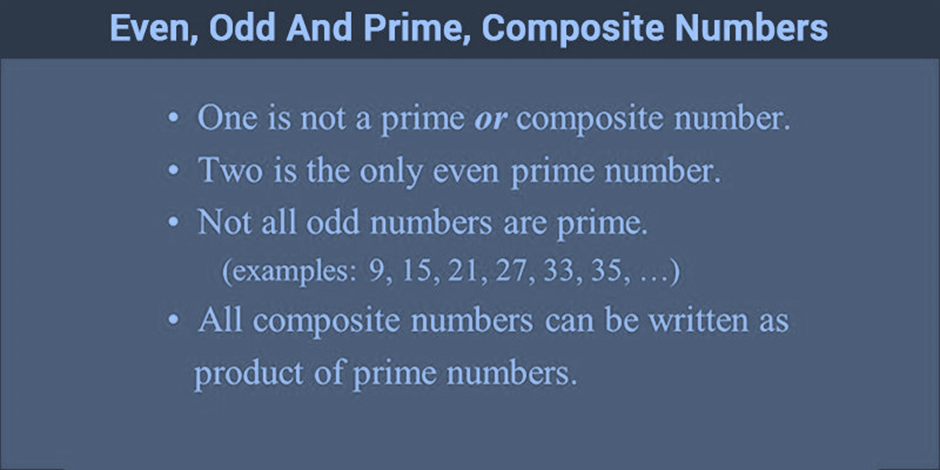
Sieve of Eratosthenes is a system to find the prime Numbers and composite Numbers from the group of Numbers. A Greek Mathematician Eratosthenes, in the third century B.C introduced this.
The Sieve of Eratosthenes system is easy to find the prime Numbers from a set of Numbers.
The way to find the prime Numbers
from 1 to 100 are as follows
Step 1 First write all the natural Numbers from 1 to 100,row-wise and column-wise as shown in the below figure.
Step 2 put a cross over 1, as it's neither a prime number nor a composite.
Step 3 Now, encircle the number 2(which is a prime number) and cross all the multiples of 2, similar as, and so on. Since all the multiples of 2 are composite.
Step 4 next, encircle the number 3, and put a cross over all the multiples of 3, similar as, etc. Since piecemeal from 3 all its multiples are composite.
Step 5 makes circle the number 5 and put a cross over all the multiples of 5.
Step 6 Now encircle 7 and cross all the multiples of 7
Step 7 Encircle 11 and cross all the multiples of 11
Step 8 Continue the process unless all the Numbers are moreover encircled or crossed.
Composite number is a number with any set of Numbers that don't have any other common factor other than 1. It's also known as fairly prime Numbers.
Properties of co-prime Numbers
• All prime Numbers are co-prime to each other.
• Any successive whole Numbers are always co-primed.
• Sum of any two co-prime Numbers is always co-primed.
•Co-prime Numbers need not be prime Numbers.
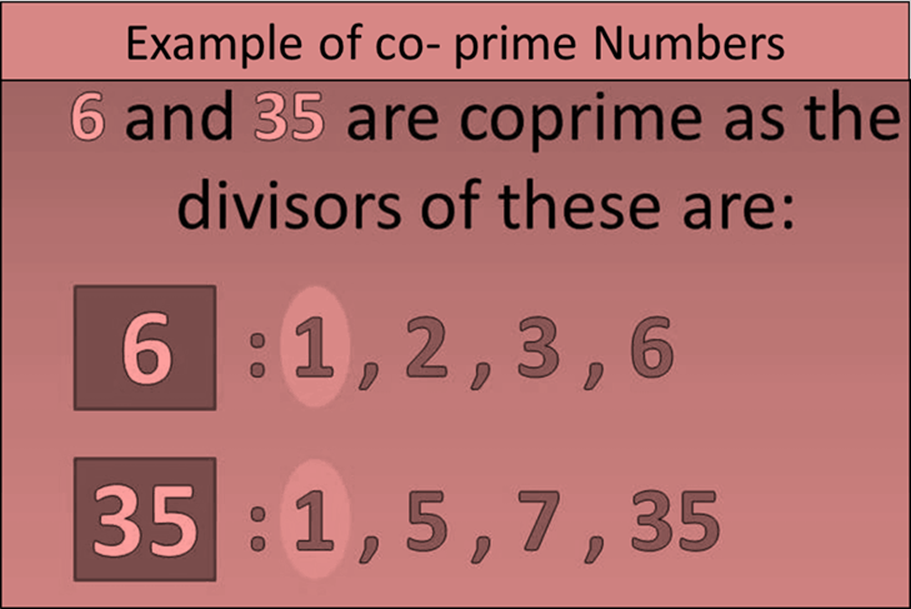
Twin prime are a match of prime numbers that differ by 2.
3.1 Factors and Multiples
The numbers that can be divided completely by another number is known as factor.
When a number is multiplied by a natural number then the number we get in result is called Multiple of that Number.
E.g. 18 is a multiple of 1,2,3,6,9,18 and
∴ 2,5 and 10 are the factors of 10.
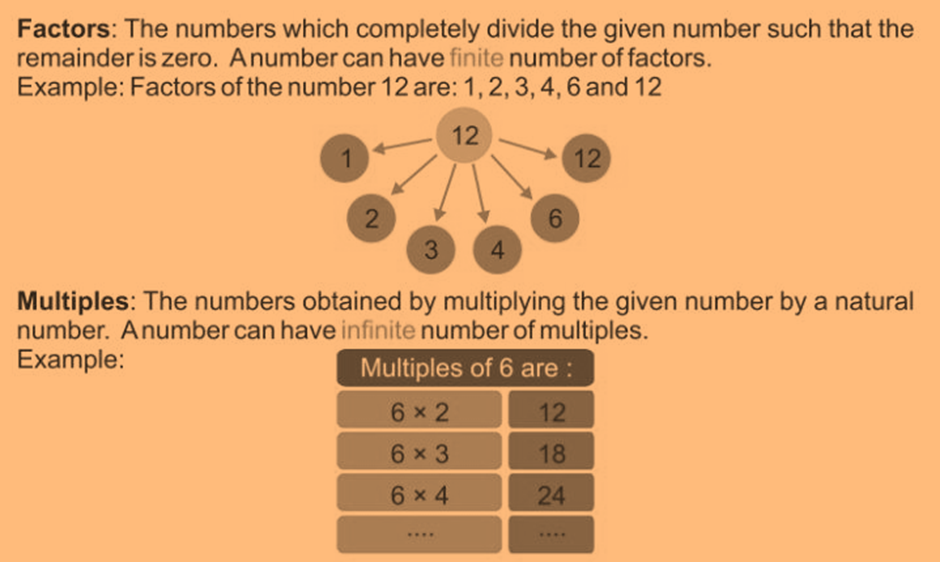
2. Divisibility Rule
- Books Name
- CBSE Class 6 Mathematics Book
- Publication
- Param Publication
- Course
- CBSE Class 6
- Subject
- Mathmatics
Some problems on HCF and LCM
Ex. Find the greatest number which divides 43 and 91 leaving remainder 7 in each caes.
Sol. It is given that the required number when divides 43 and 91, the renainder is 7 in each case . This means that 43 – 7 = 36 and 91– 7 = 84 are completely divisible by required number .
Also, the required number is the greatest number satisfying the above property .
∴ It is the HCF of 36 and 84.
36 = 2 × 2 × 3 × 3
84 = 2 × 2 × 3 × 7
∴ Required HCF = 2 × 2 × 3 = 12
Hence, the required number = 12
Ex. Find the largest number that will divide 20, 57 and 85 leaving remainders 2, 3 and 4 respecitively.
Sol. Clearly, the required number is the HCF of the number 20 – 2 = 18, 57 – 3 = 54 and 85 – 4 = 81.
18 = 2 × 3 × 3
54 = 2 × 3 × 3 × 3
81 = 3 × 3 × 3 × 3
∴ Required HCF = 3 × 3 = 9
Hence, the required number = 9
Relationship between HCF and LCM
Let us take two numbers, say 16 and 24.
The HCFof 16 and 24 is 8.
The LCM of 16 and 24 is 48.
Since 8 is factor of 48, so we can say that HCF of the numbers is a factor of their LCM.
Product of HCF and LCM = 8 × 48 = 384
Product of Numbers = 16 x 24 = 384
So we can say that the product of two numbers is equal to the product of their HCF and LCM.
Let a and b are two numbers then
a x b = HCF × LCM
Ex. The HCF of two number is 29 and their LCM is 1160. If one of the number is 145, find the other.
Sol. We know that
Product of the number = HCF × LCM
x × 145 = 29 × 1160

∴ Required number = 232
Ex. Find the least number which when divided by 6, 7, 8, 9 and 10 leaves reamainder 1.
Sol. As the remainder is same
Required number = LCM of divisors + Remainder
= LCM (6, 7, 8, 9, 10) +1
= 2520 + 1 = 2521
Ex. Find the least number which when decreased by 7 is exactly divisible by 12, 16, 18, 21 and 28.
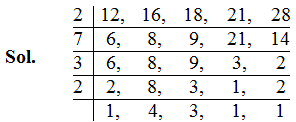
LCM = 2 × 7 × 3 × 2 × 4 × 3 = 1008
Required number = 1008 + 7 = 1015.
2. Divisibility Rule
- Books Name
- Class 6 Mathematics Book
- Publication
- ReginaTagebücher
- Course
- CBSE Class 6
- Subject
- Mathmatics
Tests for divisibility of Numbers
Divisibility rule of 2 and 4?
We can tell if 2 divides into this number without a remainder by just looking at the last number-the last number is a 4.
This means that the number is Even and 2 will divide into it without a remainder is divided by 2.
The Rule for 2 any whole number that ends in 0, 2, 4, 6, or 8 will be divided by 2.
A number is divided by 3 if the sum of the integers of the number is divided by 3.
The Rule for 4 if the last two integers of a whole number are divided by 4, also the entire number is divided by 4.
Tests for divisibility of numbers 5- 8,
The Rule for 5 Number that are divided by 5 must end in 5 or 0.
A number is divided by 6 if the number is divided by both 2 and 3.
A number is divided by 7 if the given number is divided by 7
The Rule for 8 if the last three integers of a whole number are divided by 8, also the entire number is divided by 8
Tests for divisibility of numbers 9- 11
A number is divided by 9 if the sum of the integers is divided by 9.
The Rule for 10 numbers that are divided by 10 need to be even and divided by 5, because the prime factors of 10 are 5 and 2. Primarily, this means that for a number to be divided by 10, the last number must be a 0.
A number is divided by 11 if the sum of the integers is divided by 11.
Some results on divisibility rule
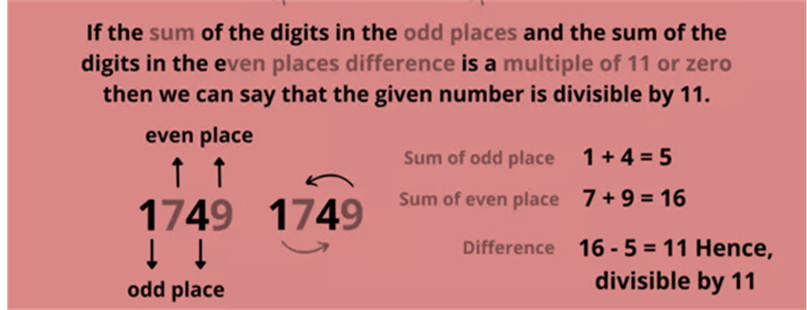
3. LCM and HCF
- Books Name
- CBSE Class 6 Mathematics Book
- Publication
- Param Publication
- Course
- CBSE Class 6
- Subject
- Mathmatics
Lowest Common Multiple
The Lowest Common Multiple (LCM) of two or more given numbers is the lowest (or smallest or least) of their common multiples.
Ex.: Find the LCM of 24 and 90.
Sol.: The prime factorisations of 24 and 90 are:
24 = 2 × 2 × 2 × 3; 90 = 2 × 3 × 3 × 5
In these prime factorisations the maximum number of times the prime factor 2 occurs is three; this happens for 24. Similarly, the maximum number of times the prime factor 3 occurs is two; this happens for 90. The prime factor 5 occurs only once in 90.
Thus, LCM = (2 × 2 × 2) × (3 × 3) × 5 = 360
3. LCM and HCF
- Books Name
- Class 6 Mathematics Book
- Publication
- ReginaTagebücher
- Course
- CBSE Class 6
- Subject
- Mathmatics
Common factors and common multiples
What are Multiples?
Multiple is a result attained by multiplying a number by an integer (it should not be a bit). By taking out the product of the counting numbers and that of whole numbers the multiples of the whole number are attained. For illustration, if we
multiply number 6 by 1,number 6 by 2, number 6 by 3, and so on then we can find the multiples of number 6,
The multiples are the product of this addition. Every multiple of a number is lower than or equal to that number.
The number of multiples of given number is infinite
Common Multiple: common multiples of numbers are the
Multiple of numbers that are common to two numbers .
Common Factors: Factors that are common to two or more numbers are known as their common factors.
Factors of 30 and 45 are –
30 = {1, 2, 3, 5, 10, 15, and 30}
45 = {1, 3, 5, 9, 15, 45}
1, 3, 5 and 15 are the Common factors of 30 and 45.
For illustration, the factors of 20 are 1, 2, 4, 5, 10, and 20.
For illustration, the multiples of 20 are 20, 40, 60, 80, 100, etc.
- Some more divisibility rules
If the number of integers of a number is even, also add the first number and subtract the last number from the rest of the number.
Example 3784
Number of integers = 4
Now, 78 3 – 4 = 77 = 7 × 11
Therefore, 3784 is subtract by 11
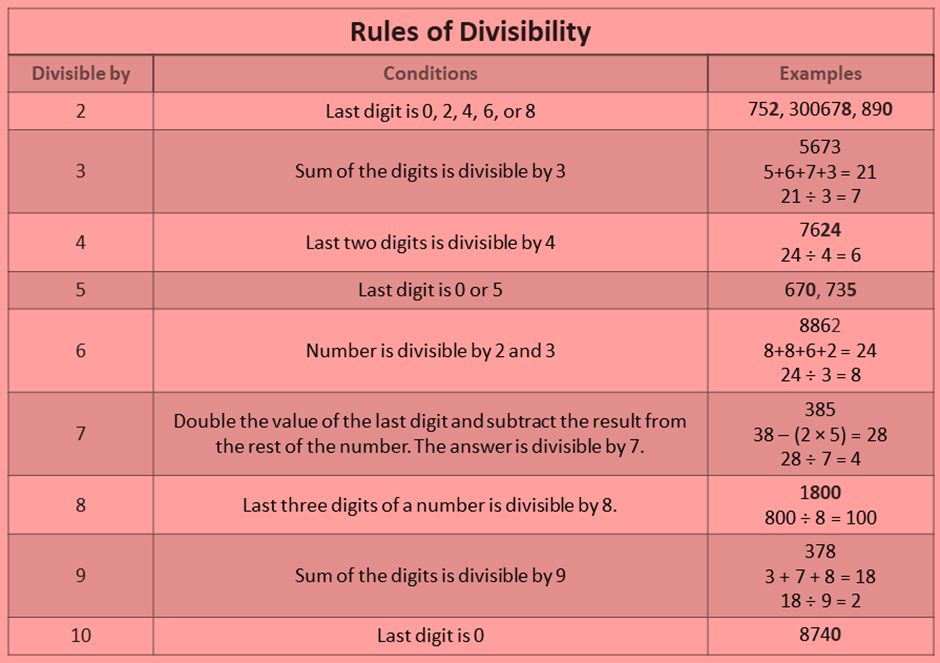
If the number of integers of a number is odd, also subtract the first and the last integers from the rest of the number.
Illustration 82907
Number of integers = 5
Now, 275 × 11 = 290 – 8 – 7
Therefore, 82907 are subtracting by 11.
Form the groups of two integers from the right end number to the left end of the number and add the even groups. However, also the number is subtracting by 11, if the sum is a multiple of 11.
Example 3774 = 37 74 = 111 = 1 11 = 12
3774 isn't subtracted by 11.
253 = 2 53 = 55 = 5 × 11
253 is subtracting by 11.
Subtract the last number of the number from the rest of the number. However, also the original number will be subtracting by 11, if the attendant value is a multiple of 11.
Example 9647
964 – 7 = 957 = 9647
95 – 7 = 88 = 8 × 11 =957 =
Therefore, 9647 is subtracted by 11.
Divisibility Rule of 12
Still, also the number is subtracting by 12 exactly, If the number is subtract by both 3 and 4.
Illustration 5864
Sum of the integers = 5 8 6 4 = 23 (not a multiple of 3)
Last two integers = 64(subtract by 4)
The given number 5846 is subtracting by 4 but not by 3; hence, it isn't subtract by 12.
Divisibility Rules for 13
For any given number, to check if it's subtract by 13, we've to add four times of the last number of the number to the remaining number and repeat the process until you get a two-number number. Now check if that two-number number is subtracting by 13 or not. However, also the given number is subtracting by 13, if it's subtract.
For illustration 2795 → 279(5 x 4)
→ 279(20)
→ 299
→ 29(9 x 4)
→ 29 36
→ 65
Number 65 is subtracting by 13, 13 x 5 = 65.
Prime Factorisation
Prime factorization is to write a composite whole number as the product of prime numbers only.
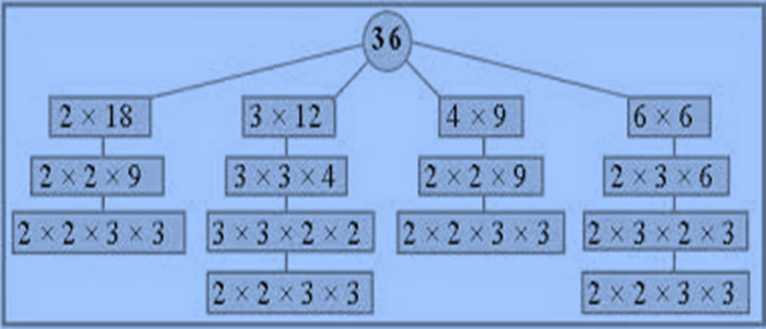
Highest common factor
HCF) of two or more given Numbers is the Highest (or topmost) of their common factors. It's also known as Greatest Common Divisor (GCD).
The topmost common factor of given numbers is called H.C.F.
To find the HCF of two or more Numbers, we can use any of the given system.
1. Common factor system
2. Prime factorization system
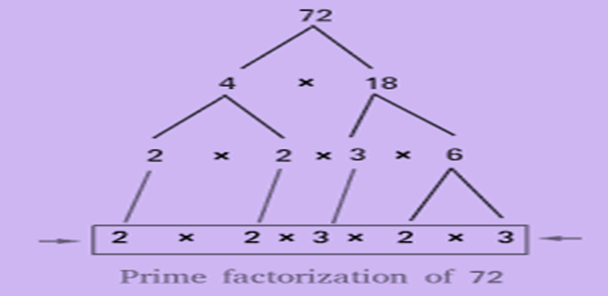
Lowest Common Multiple
The smallest common multiple of given numbers is called L.C.M.
L.C.M. of two or more high numbers is equal to their addition.
L.C.M. of two or more high numbers is equal to 1.
Every numbers have the smallest common factor number is always 1.
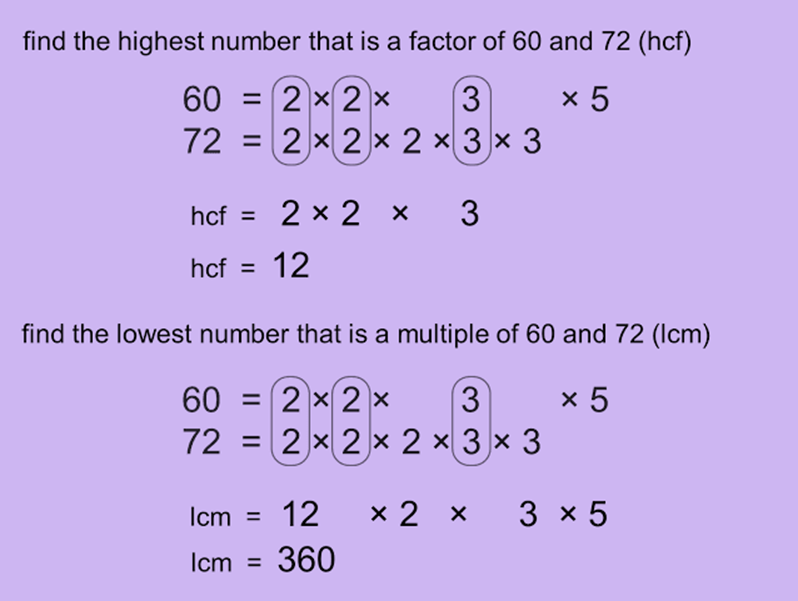
Problems on HCF and LCM
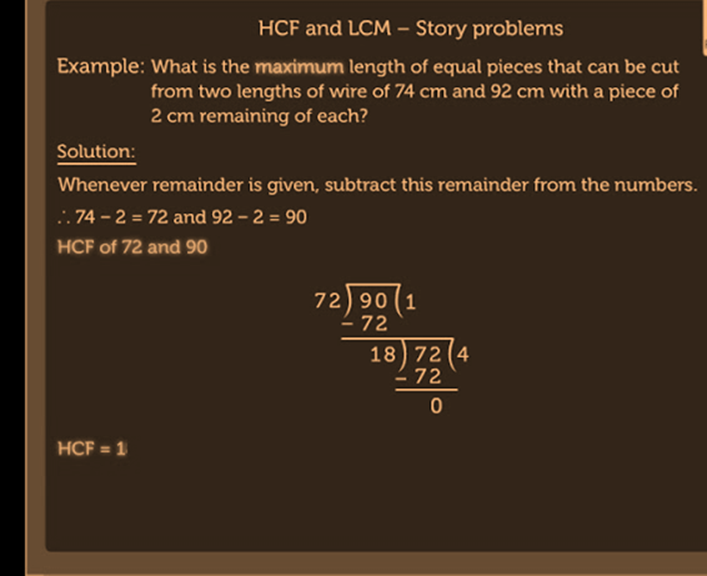
Highest Common Factor
- Books Name
- CBSE Class 6 Mathematics Book
- Publication
- Param Publication
- Course
- CBSE Class 6
- Subject
- Mathmatics
Highest Common Factor
The Highest Common Factor (HCF) of two or more given numbers is the highest (or greatest) of their common factors.
It is also known as Greatest Common Divisor (GCD).
The HCF of 20, 28 and 36 can also be found by prime factorisation of these numbers as follows:
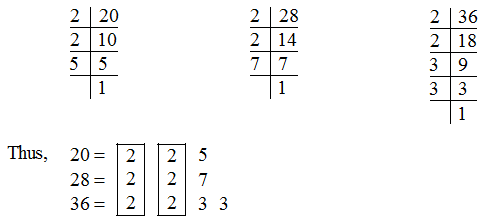
The common factor of 20, 28 and 36 is 2(occuring twice). Thus, HCF of 20, 28 and 36 is 2 × 2 = 4.
Prime Factorisation
- Books Name
- CBSE Class 6 Mathematics Book
- Publication
- Param Publication
- Course
- CBSE Class 6
- Subject
- Mathmatics
Prime Factorisation
When a number is expressed as a product of its factors we say that the number has been factorised. Thus, when we write 24 = 3×8, we say that 24 has been factorised. This is one of the factorisations of 24. The others are :

Such a factorisation of a number is called a prime factorisation.
Ex : Find the prime factorisation of 980.
Sol.: We proceed as follows:
We divide the number 980 by 2, 3, 5, 7 etc. in this order repeatedly so long as the quotient is divisible by that number.Thus, the prime factorisation of 980 is 2 × 2 × 5 × 7 × 7.

Some More Divisibility Rules
- Books Name
- CBSE Class 6 Mathematics Book
- Publication
- Param Publication
- Course
- CBSE Class 6
- Subject
- Mathmatics
Some More Divisibility Rules
(i) If a number is divisible by another number then it is divisible by each of the factors of that number.
Ex. 18 is divisible by 9. The factors of 9 is 3. 18 is also divisbile by 3.
(ii) If a number is divisible by two co-prime numbers then it is divisible by their product also.
Ex. The number 80 is divisible by 4 and 5. It is also divisible by 4 × 5 = 20, and 4 and 5 are
co-primes.
Similarly, 60 is divisible by 3 and 5 which are co-primes. 60 is also divisible by 3 × 5 = 15.
(iii) If two given numbers are divisible by a number, then their sum is also divisible by that number.
Ex. The numbers 16 and 20 are both divisible by 4. The number 16 + 20 = 36 is also divisible by 4.
(iv) If two given numbers are divisible by a number, then their difference is also divisible by that number.
Ex. The numbers 35 and 20 are both divisible by 5. Is their difference 35 – 20 = 15 also divisible by 5.
Common Factors and Common Multiples
- Books Name
- CBSE Class 6 Mathematics Book
- Publication
- Param Publication
- Course
- CBSE Class 6
- Subject
- Mathmatics
Common Factors
The factors of 4 are 1, 2 and 4.
The factors of 18 are 1, 2, 3, 6, 9 and 18. The numbers 1 and 2 are the factors of both 4 and 18.
They are the common factors of 4 and 18.
Two numbers having only 1 as a common factor are called co-prime numbers. Thus, 4 and 15 are
co-prime numbers.
Common Multiples
The multiples of 4 are 4, 8, 12, 16, 20, 24, ...
The multiples of 6 are 6, 12, 18, 24, 30, 36, ...
We observe that 12, 24, 36, ... are multiples of both 4 and 6.
They are called the common multiples of 4 and 6.
Ex. Find the common multiples of 3, 5 and 6.
Sol. Multiples of 3 are 3, 6, 9, 12, 15, 18, 21, 24, 27, 30, 33, 36, ...
Multiples of 5 are 5, 10, 15, 20, 25, 30, 35, ...
Multiples of 6 are 6, 12, 18, 24, 30, ...
Common multiples of 3, 5 and 6 are 30, 60, ...
Test For Divisibility Of Numbers
- Books Name
- CBSE Class 6 Mathematics Book
- Publication
- Param Publication
- Course
- CBSE Class 6
- Subject
- Mathmatics
DIVISIBILITY TEST
(a) Divisibilit by 2 : A given number is divisible by 2, if its unit digit is any of 0, 2, 4, 6, 8 e.g. 4268134 is divisible by 2 while 311267429 is not divisible by 2.
(b) Divisibility by 3 : A number is divisible by 3, if sum of its digits is divisible by 3 e.g. 252771 is divisible by 3 as sum of its digits (2 + 5 + 2 + 7 + 7 + 1 = 24) is divisible by 3.
(c) Divisibility by 4 : A number is divisibly by 4 if the last two digits of the number is divisible by 4 or the number ends with '00'. e.g. 213428 is divisible by 4 as last two digits is 28 which is divisible by 4. 1246800 is also divisible by 4 as the number ends with 00.
(d) Divisibility by 5 : A number is divisible by 5 if its unit place digit is either 0 or 5.
(e) Divisibility by 6 : A number is divisible by 6 if it is divisible by 2 and 3 both. e.g., 254784 is divisible by 6 because it is an even number and hence divisible by 2, also the sum of digits i.e., 2 + 5 + 4 + 7 + 8 + 4 = 30 is divisible by 3. Hence the number is divisible by 6.
(f) Divisibility by 8 : A given number is divisible by 8 if the number formed by last three digits of the number is divisible by 8 or the number ends with '000' e.g., 342840 is divisible by 8 because 840 is divisible by 8. 29342000 is also divisible by 8.
(g) Divisibility by 9 : A number is divisible by 9 if the sum of digits of the number is divisible by 9. e.g. 284796 is divisible by 9 because sum of digits 2 + 8 + 4 + 7 + 9 + 6 = 36 is completely divisible by 9.
(h) Divisibility by 10 : A number is divisible by 10 if the unit place digit of given number is '0' e.g., 21380, 3142900 are divisible by 10, whereas 214385, 329212, 46843 are not divisible by 10.
(i) Divisibility by 11 : A number is divisible by 11 if the difference between the sum of the digits in the odd places and the sum of the digits in the even places is either O or completely divisible by 11. e.g., 6584919 is divisible by 11 because. (Sum of digits at odd places) – (Sum of digits at even places)
⇒ (6 + 8 + 9 + 9) – (5 + 4 + 1)
⇒ 32 – 10 = 22, which is divisible by 11.
(j) Divisibility by 12 : If a given number is divisible by both 3 and 4 then it is also divisible by 12 e.g., 16128 is divisible by both 3 and 4 and hence it is divisible by 12 also.
Types of Numbers
- Books Name
- CBSE Class 6 Mathematics Book
- Publication
- Param Publication
- Course
- CBSE Class 6
- Subject
- Mathmatics
Types of Numbers
(a) Even Number : A number which is exactly divisible by 2 is called an even number.
Examples of even numbers are : 0, 12, 34, 56, 78,....
(b) Odd Number : A number which is not exactly divisible by 2 is called an odd number.
Examples of odd numbers are : 1, 13, 15, 25, 29,....
(c) Prime Numbers : A natural number greater than 1, which has no factors except 1 and itself is called a prime number.
Examples of prime numbers are : 2, 3, 5, 11, 13, 17, ...
(d) Composite Numbers : A number is composite if it has at least one factor other than 1 and itself.
Examples of composite numbers are : 4, 6, 8, 9,10, 12, 14,...
Note :
(i) 1 is neither prime nor composite.
(ii) Every natural number except 1 is, either a prime number or a composite number.
(iii) 2 is the only prime number which is even. All other prime numbers are odd.
(f) Perfect Numbers : If the sum of all the factors of a number is twice the number, then number is called a perfect number. For example, 6 is a perfect number since the factors of 6 are 1, 2,3, 6 and their sum 1 + 2 + 3 + 6 = 2 × 6.
(g) Coprime Numbers : Two numbers are said to be coprime if they do not have a common factor other than 1.
Examples of coprime numbers are : (8, 15); (5, 9); (2, 11)
Note :
(i) Two prime numbers are always coprime.
(ii) Two coprime numbers need not be both prime numbers.
Factors and Multiples
- Books Name
- CBSE Class 6 Mathematics Book
- Publication
- Param Publication
- Course
- CBSE Class 6
- Subject
- Mathmatics
Multiples
Just as 1,2,3, and 6 are factors of 6 , we say that 6 is multiple of 1,2,3, and 6.
A number is a multiple of each of its factors
Important results :
(a) Every number is a multiple of itself.
(b) Every multiple of a number is equal to or greater than the number.
(c) Every number has as infinite number of multiples.

 Param Publication
Param Publication
 ReginaTagebücher
ReginaTagebücher
